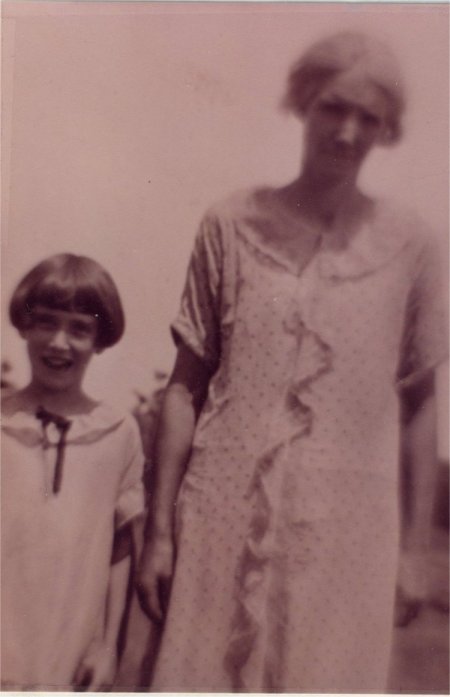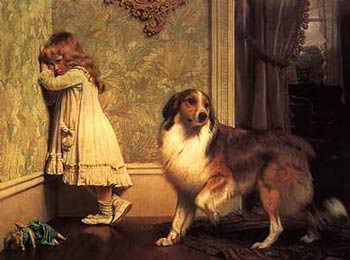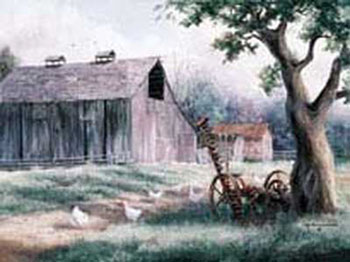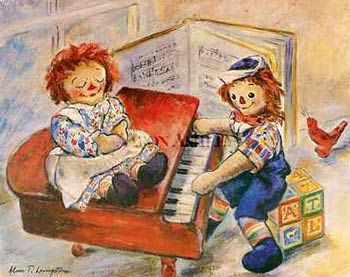![]()
Chapter 3: Moving and the New Home
I was three years old when my father bought his first farm a mile down the road from us. It was 1919 and the First World War was just ending. I use the word 'road' loosely since in reality it was just a dirt path. My dad hoped the road would stay frozen until after moving day. You could sink out of sight in those Iowa roads in springtime. The frozen ground would quickly turn to a black, gooey mud at the first hint of spring.
Moving day on the farm was always on March 1. Rain or shine, cold or warm, snow or blizzard, every farmer who moved, did so on March 1. It was hard work, but it was a very exciting time. For me, it was my very first real memory.
On that memorable morning my mother awakened me and told me to eat my breakfast -- oatmeal, no doubt. I still eat it.
I could hear the voices of the men who had come to help us move. It was still dark outside. They began loading the real heavy stuff onto the wagons -- the stoves. Oh yes, before we go on let me tell you about the stoves.
![]()
The Range
All our cooking was done on a big heavy stove, called a range. Cobs, wood and sometimes coal were burnt in its firebox. We used the range for cooking and for heat. Usually, cobs and wood were used instead of coal. Money was scarce and coal was expensive. Cobs and wood were free.
We had tons of cobs when we shelled corn. Wood was obtained by trimming dead limbs from the trees in our grove. Every farm had a grove of trees, which in addition to supplying us with wood for the range, also added beauty to the farmstead and sheltered us from the cold northwest winds.
On moving day mother no doubt used cobs when she cooked breakfast. She would use them since they heated up fast and cooled down just as fast.
![]()
The Base Burner
In addition to our range we also had another stove, the base burner, which burned coal and was used to keep the house warm. A big bucket of coal was poured into a bin over the stove, which continually spilled coal into the firebox. Although the base burner was usually kept burning all night long, my mother let it go out on this night so it would be cool enough for the men to handle.
Oh yes, the stoves were always set just far enough from the wall so that on cold winter mornings, a little girl could crawl in behind and get dressed. It was so nice and warm back there.
Back to moving:
As soon as breakfast was over, with a lot of grunting and groaning, the two
monster stoves were loaded onto a wagon. They were also the first to be unloaded
if we wanted any heat and supper that night. We always gave dinner to those that
helped us move.
the two
monster stoves were loaded onto a wagon. They were also the first to be unloaded
if we wanted any heat and supper that night. We always gave dinner to those that
helped us move.
After the stoves were loaded, we loaded up the rest of the furniture on a hayrack. In the back of my mind I seem to remember that first moving day as very mild. Mother had told me I could ride in the hayrack with the furniture while my brother, Everett, drove the horses. Everett had taken two kitchen chairs and plopped them up at the front of the rack where we could sit. Could I be riding in such style? Everett was so grownup. I thought so. All that responsibility. He was 11 years old. I was 3. After all the furniture was loaded, I ran out to the rack and was met by a neighbor boy who said he was going to help the most beautiful girl in the world onto the rack. With that he picked me up and lifted me upon the load of furniture. This was probably my first compliment. Enough of that.
I remember climbing over several pieces of furniture to reach the front, where I would sit on my chair besides Everett. Royalty, no less. I have always wondered how my parents could have permitted an eleven-year-old boy and his three-year-old little sister to drive a team of horses down the road pulling a hayrack loaded with furniture. Alone. Of course, it was only a mile and there were snow banks on either side of the road. At that time the roads had no ditches. In front of us my mother drove the team pulling the wagon with the two stoves. The two monsters. Could it be that they had given us the oldest, slowest team of horses they owned ? It was more fun to think that we were driving the frisky ones.
The hogs and chickens were hauled in wagons pulled by horses. The chickens were placed in slatted crates and loaded on the wagons. The hogs were also taken on wagons. Then, after everything else was gone, the cows were driven on foot. The men carried prodding sticks just in case a cow had a different idea about where she was supposed to go. The hogs squealed, the cows bellowed, and the chickens cackled. Perhaps they did not like the goings on.
So here I sit, knitting my sweater and recalling those young childhood days in Curlew. Am I boring you ? I'm sure you've got hundreds of stories of your own. I would love to hear them sometime. But let me continue. That moving day was probably my first real memory ...
So we all moved to our new farm, leaving behind the little house of my birth and the big house nearby. This new home would be the place where I would spend the rest of my childhood. I would have so many memories of this new home. Memories to last a lifetime.
Our new farm was a mile north and three-quarters of a mile west of Curlew on the north side of the road. The farm, although the buildings are mostly different, is still there. It was back from the road with a long lane of 125 yards. I know this for a fact since later when my brothers, Everett and Russell, were in high school, they measured it so they could practice the 100-yard dash. At first it didn't seem like home -- I still yearned for that first little house a mile down the road. I had used it for my own pretend home for so long.
![]()
Arriving at the New Home
When we arrived at our new home on that mild March day, the men herded the livestock to their new homes and the stoves were quickly set up in the house. My brothers raced into the house and up the stairs with me right behind. There was one small room with a little window, which they quickly claimed for themselves as they raced through. Another small room with two windows was claimed by my older sisters, Pauline and Helen. Pauline and Helen were my oldest siblings with Russell and Everett next in line. I was the little squirt.
The upstairs also had one large bedroom, and that would be my parents' room. What about me ? A small cot was set up in my parents' room and that would be my bed. It was nice to sleep so close to mom and dad. Safe and cozy.
After inspecting
the upstairs, we all raced back downstairs to check out the rest of the house.
There was a good-sized kitchen, a living room, and a nice bedroom. The kitchen
was large enough for the range and a large table. In the living room we placed
the davenport, a large library table, two rocking chairs, and a few assorted
straight chairs. Oh yes, and the big base burner. So important. There was also a
downstairs' bedroom that we used for guests. We also put a piano in that
bedroom. (That was the only place left for it.)
the house.
There was a good-sized kitchen, a living room, and a nice bedroom. The kitchen
was large enough for the range and a large table. In the living room we placed
the davenport, a large library table, two rocking chairs, and a few assorted
straight chairs. Oh yes, and the big base burner. So important. There was also a
downstairs' bedroom that we used for guests. We also put a piano in that
bedroom. (That was the only place left for it.)
Soon, heat was radiating from the big old base burner. Let me tell you some more about the stoves. The two monsters. I hope I am not boring you with stoves, but you must realize how important they were to us.
![]()
Monster Number 1
Monster Number 1 -- the range. The range was constructed of cast iron. It was as heavy as a battleship. There was a firebox at one end where cobs and wood were burnt. Since the hottest spot on the stove was right above the firebox, most of the cooking was done there. The area farther away from the firebox was used for slower cooking. Directly under the firebox was an ash pan which required emptying once a day.
And guess who emptied it ? And heaven forbid if you let the ashes build up. You would find the pan almost impossible to remove since ashes would be crammed in there a mile high. And when you did manage to pull the pan out, the ashes would scatter all over the floor. What a mess! Next, in our range tour, at the opposite end from the firebox, was a reservoir, that held about five gallons of water. At least. This water was used to wash dishes or your hands and face. It stayed warm all the time. We kept it filled by carrying water from our ground well.
And finally, the last feature of the range was a nice big oven, where my mother baked the most delicious pies and cakes. The temperature of the oven was controlled by how many cobs you put in the firebox. A person learned how many cobs was needed to make a good pie. Later, when I did my own cooking, I made many angel food and boiled raisin cakes on a range just like this. Nowadays, I use a microwave. It is a lot easier, but I'm not sure it has as many memories.
![]()
Monster Number 2
Although the range gave out enough heat to keep the house comfortable in the spring and fall, it was the huge base burner that was our primary source of heat when it got really cold. It sat majestically in the living room, and it was in front of this big old stove where we spent our long winter evenings. In the spring my father would take it apart and store it in the washhouse. When he brought it back into the house in the winter, the first thing that had to be done was wash the little isinglass windows in the door. Those little windows were washed with vinegar. I know this for a fact since it was my job to wash them. I always liked doing this, for they looked so shiny when I was done. You could see the fire dancing through these windows on a cold winter night. The stove was set off at each corner by ornate chrome decorations. In the wintertime when the wind howled outside, I loved to sit in front of this huge warm old stove, probably reading a Bobbsie Twin book, and smelling cookies in the oven. Since the fire never died out at night, we would always warm ourselves in front of it in the early morning.
The bedrooms were freezing cold in those days. My mother always kept her flatiron warming on a mantel at the back of the base burner. Then, when I went to bed she would take the iron and wrap a blanket around it, and put it under my covers next to my feet. Years later, when I would come home from a date, my date would look on the base burner to see if my iron was waiting for me. He didn't want my feet to get cold, he'd tease me.
---
Later, after my older sisters, Pauline and Helen, had graduated from school and left home, I moved into their room. It was nice to have my own bed. No more cot. The room had two small windows where a cool breeze came through in the summertime. When I went to bed, I often complained about the heat. My mother would come to my room and tell me to lay very still, and I would cool off. The first thing I knew it was morning and I wondered where the night had gone.
I must also tell you about our mattresses. The ones on my bed and my parents' bed were regular mattresses. Of course, they were not innerspring mattresses, but were sort of like an exercise mat you might find in a fitness gym. The mattress on Everett and Russell's bed was not a mattress at all -- but a husk mattress. If this style is unfamiliar to you, let me make one for you. Just begin by taking a large sack the size of a bed made of striped ticking, a fabric similar to denim. Then, stuff it with cornhusks. But, be sure not to get any cobs in with the cornhusks. It isn't much fun to have a cob stuck in your back all night long.
Oh yes, the house. I almost forgot. It's getting so easy to lose my train of thought.
![]()
What a Mess
A few weeks after we moved into our new house the snow melted and my mother began wondering what all that junk was in our front yard. Cans, bottles, paper, string, ashes, potato peelings and anything and everything you can imagine was there. "Good grief, did they just go to the door and throw?" she wondered. It wasn't long before it was cleaned up.
Our new house also had dozens of holes in the walls. It was by no means a new house. My father covered the holes with pieces of cloth and pasted over them. The paste was made by mixing flour and water, and then adding water and boiling all this together. After cooling, it was ready to spread. We then painted the walls with a 'whitewash' substance, which we made by mixing calsomine, a colored powder, with water. After the walls were painted, they smelled so nice and clean. I think that house had a cleaning like it never had before. My mother was an immaculate housekeeper.
![]()
The Washhouse
Near the house was a small washhouse that housed a washing machine, a cream separator, and a small stove used to heat the washhouse in the winter. At the back of the washhouse was a small room where we kept the coal for Monster Number 2.
Washing day was always on Monday. Water from our well was used and lye was added to the water to soften it. After the lye was added and the water heated, a thick ugly scum, at least an inch thick, formed on top. This scum was then skimmed off with a small pan. All children were cautioned to stand back since lye water would cause nasty burns. As unpleasant as adding lye was, it was necessary if you wanted clean clothes.
If rainwater was available, it was not necessary to soften the water. The washing machine was powered by a gas engine. Later, better machines that had a small Maytag, or a Briggs and Stratton engine mounted below the washtub were introduced. What great machines they were. The freshly washed clothes were always hung outside on a clothesline which was located in the backyard. In wintertime the clothes would freeze, stiff as a board. Fingers sometimes got stiff too.
The washhouse also
had a cream separator that was used twice a day -- every time my dad milked the
cows. My dad carried the pails of milk from the barn to the washhouse where he
poured the milk into the separator. He then turned the crank on the separator
and the milk flowed through a fast turning cylinder which separated the cream
from the milk. Often, I would bring a cup and catch some of the skim milk as it
left the separator. Warm and very good. The cylinder that separated the cream
from the milk spun very fast, and one day I decided to stop it. That wasn't a
good idea. I received a large, painful blood blister on my finger. I never tried
that again.
my dad milked the
cows. My dad carried the pails of milk from the barn to the washhouse where he
poured the milk into the separator. He then turned the crank on the separator
and the milk flowed through a fast turning cylinder which separated the cream
from the milk. Often, I would bring a cup and catch some of the skim milk as it
left the separator. Warm and very good. The cylinder that separated the cream
from the milk spun very fast, and one day I decided to stop it. That wasn't a
good idea. I received a large, painful blood blister on my finger. I never tried
that again.
Between the house and the washhouse was a walkway. Or rather I should say, a crooked dirt path. Later, a cement walkway was put in. My mother told me the people who lived in the house before us allowed a large thistle to grow beside the path. They thought it was pretty. A thistle is a noxious weed. The first thing any farmer does when he sees one is kill it. At least most farmers do. My father didn't liked thistles. One never grew there again.
---
Behind our house stood an old rain barrel which caught rainwater. Our home had no running water so this water was used to wash hair and take baths. Mosquitoes would lay their eggs in this barrel in the summertime, and there would be hundreds of little wrigglers swimming around in the water. You had to strain the water to get the little buggers out before you took your bath.
![]()
Mattresses,Telephones, etc
Let's go back into the house. I remember the time Everett and Russell finally got a new bed that had an honest to goodness mattress. I suspect that was the last time either of them ever slept on their cornhusk mattress. Anyway, I wanted that new bed so bad. My own bed had hard springs and was as solid as a ship. My brothers would push on the foot of their new bed with their feet until they eventually broke it. I told them they should have taken my bed. They certainly couldn't have broken it.
We kept warm during the winter months with double blankets. The blankets were twice as long as the bed and folded at the foot. You would lay on one end of the blanket and pull the other end over you.
We also made quilts, or comforters as they were often called. There were three layers to a comforter, the top layer was made from pieces of old coats and dresses, sewn together in a patchwork design, the middle layer was a wool batt, and the inner lining was made from flannel. It was real warm on a cold winter's night.
---
A few years after we moved into our new house, telephone lines were installed on our road. My mother and I had gone to Illinois for my grandmother's funeral. We had traveled by train, and I remember when we returned, my mother called my dad from a nearby town and asked him to pick us up at the train station. It was the first time she had ever used a telephone. I remember how excited she was over this new invention.
 Our telephone at
home was mounted on the wall and to use it you turned a little crank on the
side. Turning this crank alerted the local operator who answered, "Number
Please". You then gave her the number of the person you wanted to talk to, or if
you didn't know the number, you would give her the person's name. She would then
ring them. Every telephone had its own number. I will remember our number until
the day I die.
Our telephone at
home was mounted on the wall and to use it you turned a little crank on the
side. Turning this crank alerted the local operator who answered, "Number
Please". You then gave her the number of the person you wanted to talk to, or if
you didn't know the number, you would give her the person's name. She would then
ring them. Every telephone had its own number. I will remember our number until
the day I die.
It was 7-26. I'll bet you remember yours too.
Of course, we all had 'party lines,' which essentially meant that several families shared the same telephone -- or at least the same line. Our party line had ten parties. When the telephone rang for someone on the party line, the other telephones would also ring. That was the cue for everyone on the line to pick up the phone and 'listen in.' Listening to other person's conversations was known as rubbering, and was a favorite pastime for many -- or I should say most. In order that people on the party line know which call was intended for them, a code of long and short rings was devised. The number one was one short ring, the number two was two short rings, and so on, until you go to five, which was one long ring. Then, six was two long rings, seven was three long rings, and so on. If there was an important meeting, or if someone was reporting a fire, then an alarm of several short rings was given. This was a cue to pick up the phone and listen to the message.
In those days my dad managed a cooperative group of farmers, called the Shipping Association, that helped farmers market their livestock. He was often asked by a farmer to determine if cattle and hogs were ready for market. One day he had just gone into Curlew when a farmer called him. The operator was sitting in the telephone office in town and was looking out the window when the man called. She told him she had just seen my dad go in the drugstore and she'd ring him there. This was the way of the small town.
![]()
Continue to Chapter 4: Country School